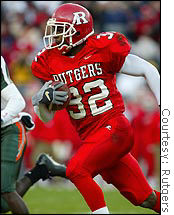
NEW YORK (CNN/Money) - Rutgers University had to be the most successful 1-11 football team in the country last year.
The state university of New Jersey is a member of the Big East -- a Division 1A college football conference. Of course any resemblance between Rutgers and a real Division 1A school seems to be purely coincidental, but it gets to cash the television rights checks that go to Big East conference members nonetheless.
Rutgers received about $2 million from the Big East last year, despite not playing in one of its nationally televised games during the season. (Its only time on national TV came as a sacrificial lamb playing Notre Dame).
 |
|
| Thanks to the Big East revenue sharing, Rutgers University is able to get $2 million in national television money despite a 1-11 record. |
So you see why Rutgers, and four other Big East colleges, are fighting attempts by the rival ACC to poach three of the Big East's top football schools, including the Division 1A school sometimes called Quarterback U. - the University of Miami - along with two other big revenue schools - Boston College and Syracuse University.
Even with some good football teams among its remaining schools, it's not likely that the Big East would be able to stay part of the Bowl Championship Series, the national coalition of six major football conferences that determines what schools will play in the national championship game and the other top-dollar, top-rated bowl games at the end of the year. It gives those six conferences about $14 million each to give to member schools. The other conferences would rather split that money five ways than six if the Big East no longer has a national powerhouse like Miami to offer.
While the Big East will probably go poaching for schools itself if it loses Miami, B.C., and Syracuse, it won't find anyone with a strong enough football program to make it attractive to the BCS. As one official involved in the fight told me, anyone with an interest in being in a diminished Big East doesn't bring enough to it.
Not that the current Big East TV money is enough to turn football into a moneymaker for Rutgers. Department of Education figures for the previous season, the most recent available, show expenses outstripping its $4.8 million in revenue by about $2 million. But a tight budget on campus becomes tighter if those losses double due to the loss of the television money.
Rutgers and the University of Connecticut, one of the other Big East schools suing the ACC, probably would have been better off not ever reaching for the football stars, rather than reach for them only to have their feet knocked out from under them.
| SportsBiz
|

|
| Click here for SI.com sports coverage
|
|
|
|
Even with the increased revenue of being a Division 1A pretender, Rutgers has continued to lose not only money but also college football's oldest rivalry, with nearby Princeton University.
UConn, with another money-losing football program, spent $90 million on a new football stadium that is unlikely to pay for itself, even if the Big East stays intact.
If they were to become Division 1AA schools, with fewer scholarships and other expenses, they would likely still lose money on football, but not as much, and they'll be losing if they stay in Division 1A without the BCS money, said Dan Fulks, a professor at Lexington, Ky.-based Transylvania University who charts sports teams' expenses and revenues for the National Collegiate Athletic Association.
"Over half schools in division 1A would be better off dropping down to Division 1AA," said Fulks. "But it's an ego problem. It's what keeps all the pretenders in Division 1A."
| Related columns
|

|
|
|
|
The three more successful football schools left in the Big East are less likely to be devastated by the loss of the national television contract, though they will be hurt. But their greater success means they'll see a bigger drop in revenue than a school like Rutgers, which never sees extra dollars from national television appearances and bowl bids.
Figures for the 2002 season show that West Virginia's football program made $6.3 million, while the University of Pittsburgh football made $5.7 million, and Virginia Tech made $3.6 million. Virginia Tech actually had more national television games than did Miami last season.
Even with a drop in television money, Fulks said they can probably continue to make money without being part of the BCS.
"Ticket revenue is the most important factor in the schools that make money," said Fulks. "My guess is Virginia Tech and West Virginia are going to always sell tickets." What else is there to do in Blacksburg and Morgantown, he asked.

|

